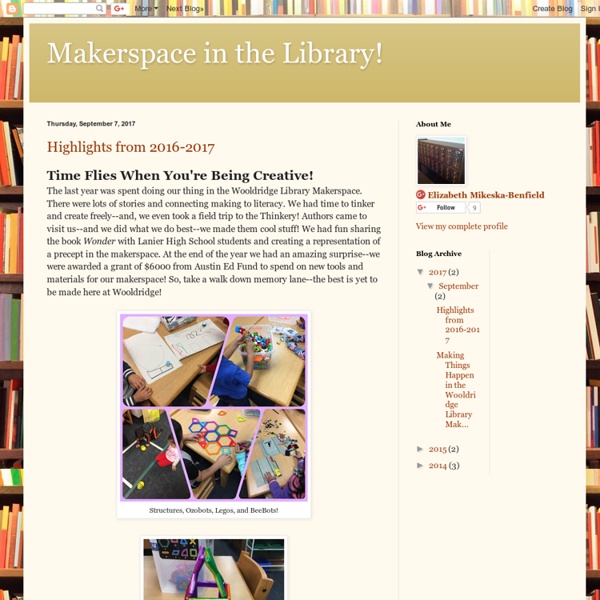



http://wooldridgelibrarymakerspace.blogspot.com/
Related: MakerspacesThe (Latecomer) Beginner's Guide To Minecraft Minecraft first came out in 2009; but just a few weeks ago it debuted on the current console generation. What makes this game endure, 5 years later – with over 15 million licensed players on the PC/Mac alone? It’s awesome, that’s what. If you’re late to the party though, don’t worry – this extensive beginner’s guide has you covered. Why Minecraft? Makerspaces, Participatory Learning, and Libraries – The Unquiet Librarian The concept of libraries as makerspaces first hit my radar last November when I read about the Fayetteville Free Library’s FabLab. As I began hearing more buzz about libraries and makerspaces the first few months of this year, I decided that learning more about this concept and exploring how I might apply the elements of makerspaces to my library program would be a personal learning project for the summer. So what is a makerspace? Makerspace defines it as: Modeled after hackerspaces, a makerspace is a place where young people have an opportunity to explore their own interests, learn to use tools and materials, and develop creative projects. It could be embedded inside an existing organization or standalone on its own.
Maker & DIY Programs Maker enthusiasts: anyone can edit this page. Please share your resources here! You may also be interested in our STEM Resources page and our Teen Programming Guidelines from YALSA (.pdf) uTEC Maker Model he uTEC Maker Model visualizes the developmental stages of creativity from individuals and groups as they develop from passively using a system or process to the ultimate phase of creativity and invention. As illustrated in the model below, there arefour levels of expertise. A Makerspace participant begins at the Using level. A User enjoys engaging in an activity to sample something new. Here individuals or groups use a tool, device, or program in the way—and for the purpose— the inventor intended.
The Maker Space Difference: Amazing Inquiry, Shared Learning Students work with the new 3-D printer. “Is it true? Do we have a 3-D printer?” When I put our new 3-D printer in the window of the school library, not only were my own maker space students interested, but the rest of the school seemed to take note. Launching a Makerspace: Lessons Learned From a Transformed School Library Excitement about school makerspaces has been in the air, but many educators eager to create hands-on learning spaces in their schools still aren’t sure how to get started or why it’s worth the effort. New Canaan High School librarian Michelle Luhtala recently jumped headfirst into creating a makerspace in her library and documented what she learned, how her space changed and how it affected students along the way. Her experience was very different from elementary school librarian Andy Plemmons, whose makerspace started with a 3-D printer obtained through a grant and blossomed into a core teaching resource at his school. Luhtala is blessed with a big library, but for most of her career it has been dominated by large bookshelves. Over time, Luhtala has pared down her collection as she increased the digital reading material the library offers, but in order to make room for a makerspace she cleared out 7,000 books.
8 Design Steps for an Academic Makerspace Hands-on Learning Page 2 of 2 8 Design Steps for an Academic Makerspace "Without this component, we see a lot of failures," he added. Jarowski also said that teachers could find interesting lesson plans that involve makerspaces online. Kristin Fontichiaro's Blog About Learning, Teaching, Making Things, and Libraries Building professional capacityTeacher-librarians are well positioned to impart data literacy to teens, but who’s giving instructors the resources and support that they need to do so?Kristin Fontichiaro, clinical associate professor at University of Michigan’s School of Information, and Jo Angela Oehrli, learning librarian at University of Michigan Library, were up for the task. As principal investigators of the two-year IMLS-funded project “Supporting Librarians in Adding Data Literacy Skills to Information Literacy Instruction,” they set out to design materials for high school librarians looking to foster data and statistical literacy skills in their students.“We were seeing on our own campus that data was becoming a powerful mode of expression and wasn’t working in ways that information literacy always works,” says Fontichiaro.